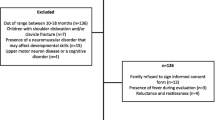Abstract
The physical examination of the young child can be difficult, especially for practitioners who do not routinely treat children. However, a good physical exam is vitally important to the proper evaluation and diagnosis of many pediatric upper extremity conditions. As many of these issues also involve other body parts and organ systems, a complete physical examination, along with a focused upper extremity examination, is important in all new patients to the pediatric hand surgeon’s office. The development of children’s motor, verbal, and social skills proceeds along a predictable path, and these developmental milestones can be used to the examiner’s advantage as the exam is tailored to the age of the child. The structure and flow of the upper extremity examination in children must be flexible, and specific examination techniques, such as the use of a retractable tape measure, can be very helpful.
In the specific cases of children with brachial plexus birth palsy and cerebral palsy, specialized examinations have been created to better standardize the evaluation of these difficult and heterogeneous conditions. For brachial plexus birth palsy, these include the Active Movement Scale (AMS) exam, as well as the modified Mallet exam. For cerebral palsy, the video-based Shriners Hospital Upper Extremity Evaluation (SHUEE) provides a comprehensive tool for evaluating a child’s functional use of their upper extremities.
Access this chapter
Tax calculation will be finalised at checkout
Purchases are for personal use only
Similar content being viewed by others
References
Abzug JM, Chafetz RS, Gaughan JP, Ashworth S, Kozin SH. Shoulder function after medial approach and derotational humeral osteotomy in patients with brachial plexus birth palsy. J Pediatr Ortho. 2010;30:469–74.
Bae DS, Waters PM, Zurakowski D. Reliability of three classification systems measuring active motion in brachial plexus birth palsy. J Bone Joint Surg Am. 2003;85-A(9):1733–8.
Bae DS, Waters PM, Zurakowski D. Correlation of pediatric outcomes data collection instrument with measures of active movement in children with brachial plexus birth palsy. J Pediatr Orthop. 2008;28:584–92.
Borschel GH, Clarke HM. Obstetrical brachial plexus palsy. Plast Reconstr Surg. 2009;124(1 suppl):144e–55e.
Case-Smith J. Grasp, release, and bimanual skills in the first two years of life. In: Henderson A, Pehoski C, editors. Hand function in the child: foundations for remediation. St. Louis MO: Mosby Year Book; 1995. p. 113–35.
Curtis C, Stephens D, Clarke HM, et al. The active movement scale: an evaluative tool for infants with obstetrical brachial plexus palsy. J Hand Surg. 2002;27A:470–8.
Davids JR, Peace LC, Wagner LV, et al. Validation of the Shriners hospital for children upper extremity evaluation (SHUEE) for children with hemiplegic cerebral palsy. J Bone Joint Surg Am. 2006;88(2):326–33.
de Roode CP, James MA, McCarroll Jr HR. Abductor digiti minimi opponensplasty: technique, modifications, and measurement of opposition. Tech Hand Surg. 2010;14:51–3.
Hsieh CH, Huang KF, LiLiang PC, et al. Paradoxical response to water immersion in replanted fingers. Clin Auton Res. 2006;16(3):223–7.
James MA (2005) The retractable tape measure in pediatric hand exams. Correspondence News of the American Society for Surgery of the Hand. October 2005, issue no. 127.
Kapandji A. Clinical test of apposition and counter-apposition of the thumb. Ann Chir Main. 1986;5(1):67–73.
Mallet J. Paralysie obstétricale du plexus brachial. Traitement des séquelles. Primauté du traitment de l’épaule – Méthode d’expression des résultats. Rev Chir Orthop Reparatric Appar Mot. 1972;58 suppl 1:166–8.
Michelow BJ, Clarke HM, Curtis CG, et al. The natural history of obstetrical brachial plexus palsy. Plast Reconstr Surg. 1994;93(4):675–80.
Murray EA. Hand preference and its development. In: Henderson A, Pehoski C, editors. Hand function in the child: foundations for remediation. St. Louis: Mosby Year Book; 1995. p. 154–63.
Wagner LV, Davids JR. Assessment tools and classification systems used for the upper extremity in children with cerebral palsy. Clin Orthop Relat Res. 2012;470(5):1257–71.
Wilder-Smith EP. Water immersion wrinkling – physiology and use as an indicator of sympathetic function. Clin Auton Res. 2004;14(2):125–31.
Author information
Authors and Affiliations
Corresponding author
Editor information
Editors and Affiliations
Rights and permissions
Copyright information
© 2015 Springer Science+Business Media New York
About this entry
Cite this entry
Bauer, A., James, M. (2015). Physical Examination. In: Abzug, J., Kozin, S., Zlotolow, D. (eds) The Pediatric Upper Extremity. Springer, New York, NY. https://doi.org/10.1007/978-1-4614-8515-5_3
Download citation
DOI: https://doi.org/10.1007/978-1-4614-8515-5_3
Received:
Accepted:
Publisher Name: Springer, New York, NY
Print ISBN: 978-1-4614-8513-1
Online ISBN: 978-1-4614-8515-5
eBook Packages: MedicineReference Module Medicine




